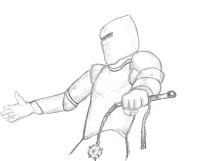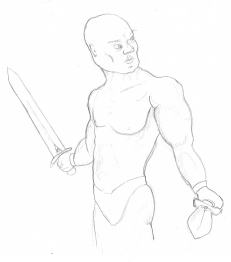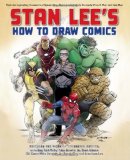
Imagine holding an arrow in your hand. Hold it so that the fearthers are pointed at the ground and the point of the arrow is pointed up toward the sky. You can see the full arrow and it is pretty large - maybe two or three feet in length. This is easy for you to draw because you see it without any distortions but...
Now imagine holding the arrow up to your face and the feathered end is pointing right at you and the tip is pointing directly away from you. Now you don't really see much of the arrow at all. It has been foreshortened! It's actual height in your eye, and on paper is now only an inch or two. Now if you rotate the arrow so that it points back up toward the sky it will grow larger and large until it reaches its full size.
This foreshortening is a skill that every artist must work on and you can get good at it with practice. Once you realize that you have to foreshorten objects or even portions of objects your eye and your ability to do it will improve.
Take another look at the drawing of the knight at the top of this page. Knights generally have two arms that are the same length right? But in this drawing the knight's left arm is drawn considerably shorter than the right arm yet it looks ok. This is a great example of foreshortening. The left arm is coming almost directly at us so it takes up less length in the picture. But another thing to remember is that the arm coming toward us is not only just shorter in length it is also bigger! What I mean here is that the knight's left fist is bigger than his right fist. This is another dimension to foreshortening. You must consider a lot of things when you are drawing objects. Look closely at the object you are drawing and try to understand what it really looks like. You have to overcome your natural tendencies when doing this. Your mind tells you that both arms are equal and both fists are the same size. But if you drew it like this it wouldn't look correct. You are now beginning to teach yourself to see things as they really are and not as you assume them to be. This is all part of tricking the eye into seeing what you want it to see.

Here is another example of foreshortening. This warrior is carrying two swords. Notice how the sword in his right hand (in the background) is pretty close to full length. But wow, what happened to the sword in his left hand. This one is pointing almost straight at us and it is pretty distorted yet it looks correct.
Can you see any other examples of foreshortening in this drawing?
The warrior's arm that is furthest away from us shows some foreshortening. It is held closer to vertical so we get a foreshortened look at it much like the sword that is closer to us. And of course the hand and arm that is closer to us is larger than the one that is further away. Keep all this in mind, look for length and look for size relative to other parts of what you are drawing.
*Time for you to practice some foreshortening
Spend at least one hour doing some foreshortened drawings. Feel free to copy these drawings if you want. And make plenty of your own drawings. The best things to draw for this example are long and thin so pick out things you can draw then draw them in different positions so you see them in a foreshortened perspective. Even a pencil works great as a model for this exercise.
 Let's Continue on to lesson 5 Dealing with distance in your drawings Let's Continue on to lesson 5 Dealing with distance in your drawings

Stan Lee's How to draw Comics - In Stan Lee's How to Draw Comics , Stan Lee sets out to teach everything he knows about drawing and comic book characters, The book focuses primarily on action-adventure comics, but will touch upon other genres and styles, such as romance, humor, horror, and the widely influential manga style. From producing concepts and character sketches to laying out the final page of art, the man with no peer-Stan Lee-is the ultimate guide to the world of creating comics.

Do you like making projects and exploring a variety of hobbies? Sign up for my free newsletter. I give you regular updates on hobbies and projects you can make. it is totally free and I don't share your email with anybody.
|
![]()







